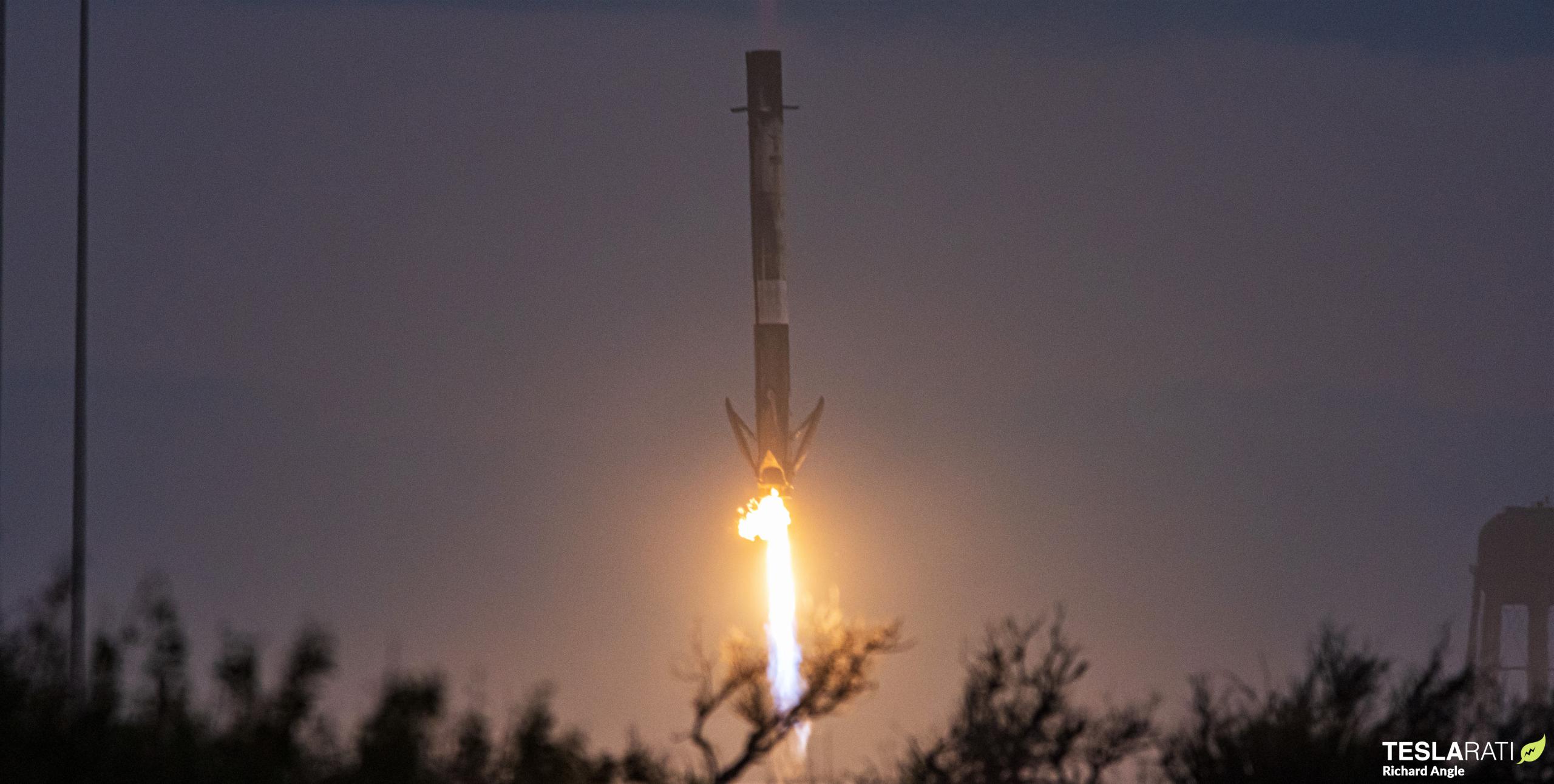
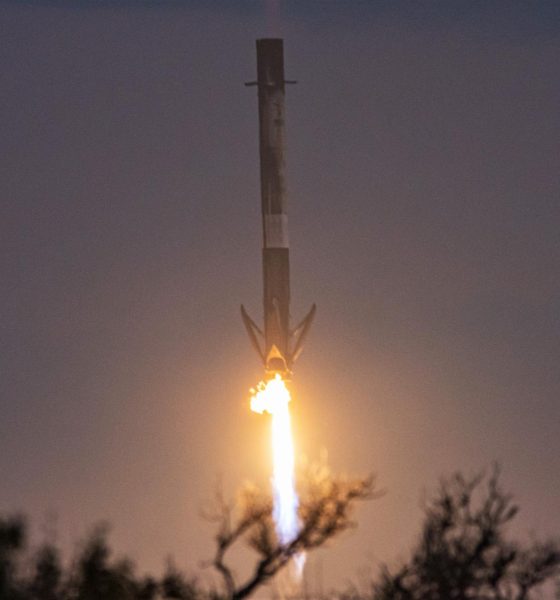
News
SpaceX sends OneWeb satellites to orbit on 55th launch of 2022
SpaceX has successfully launched the first of at least three missions for Starlink competitor OneWeb, completing its 55th launch of the year in the process.
Hopefully ending a strange series of delays that began last month, Falcon 9 lifted off from SpaceX’s NASA Kennedy Space Center LC-39A pad several days behind schedule on December 8th, 2022. The rocket performed perfectly, ascending for about nine minutes to reach a parking orbit around 400 kilometers (~300 mi) above Earth’s surface. B1069, Falcon 9’s flight-proven booster, shut down, separated from the upper stage, flipped around with cold-gas thrusters, and began boosting back to the Florida coast two and a half minutes after liftoff.
Thanks to the launch’s timing, which happened moments after sunset, B1069 first experienced sunset on the ground, ascended back into the light after liftoff, and finally experienced a second sunset while racing back to Earth – all beautifully captured by SpaceX tracking cameras. Eight minutes after liftoff, the Falcon 9 booster touched down on SpaceX’s LZ-1 landing pad, completing its fourth orbital-class launch in 12 months. Around the same time, Falcon 9’s upper stage reached orbit.
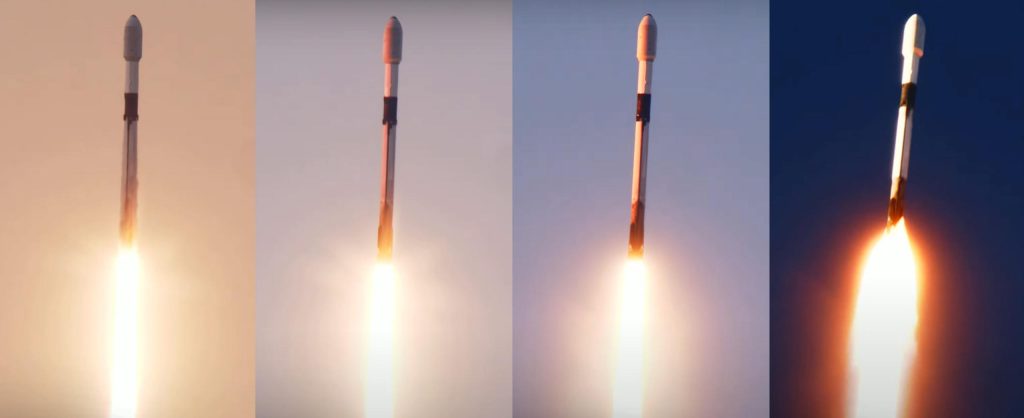
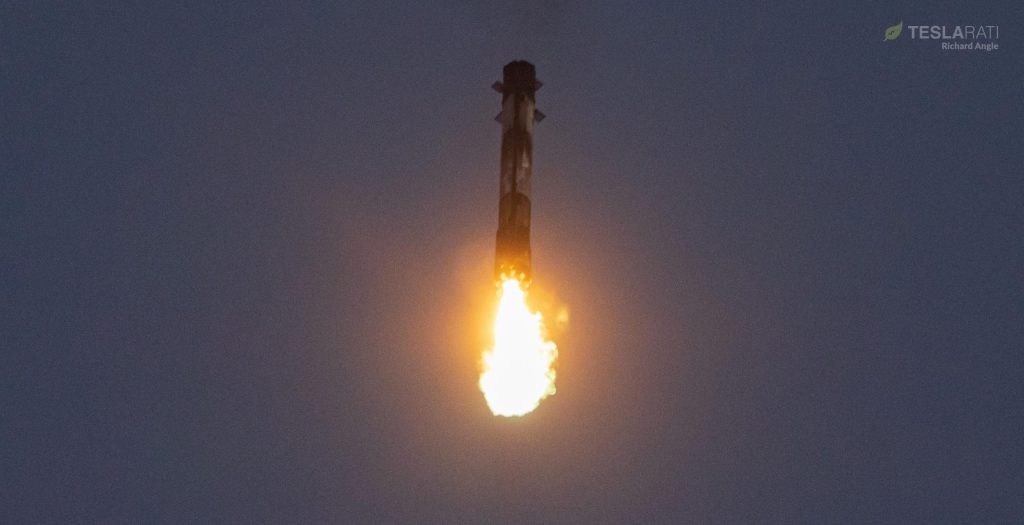
The update that's rolling out to the fleet makes full use of the front and rear steering travel to minimize turning circle. In this case a reduction of 1.6 feet just over the air— Wes (@wmorrill3) April 16, 2024
An hour after liftoff, the upper stage ignited a second time to circularize its parking orbit. Its payload – a record 40 OneWeb satellites weighing roughly 6.5 metric tons (~14,300 lb) – was then deployed in two sets of 13 and one set of 14 over the next half hour, after which the upper stage likely performed a deorbit burn to ensure it doesn’t become space debris.
For its own Starlink internet constellation, SpaceX routinely launches 54+ satellites – weighing almost 17 tons (~37,000 lb) – at once, demonstrating the kind of efficiency that can be achieved when a satellite is explicitly designed to use as much of Falcon 9’s performance as possible. To some extent, OneWeb did something similar, but for a different rocket. OneWeb’s far more traditional 150-kilogram (~330 lb) satellites were loosely designed to launch on Russia’s Soyuz 2.1 after the company purchased up to 21 of the rockets for $1-1.5 billion in 2015.
But their more traditional hollow-box design and traditional cylindrical payload dispenser means they take up as much or more space than Starlink satellites despite weighing 50-100% less. OneWeb says each satellite provides up to 7 gigabits per second (Gbps) of bandwidth, while each Starlink V1 satellite appears to have about 20 Gbps.
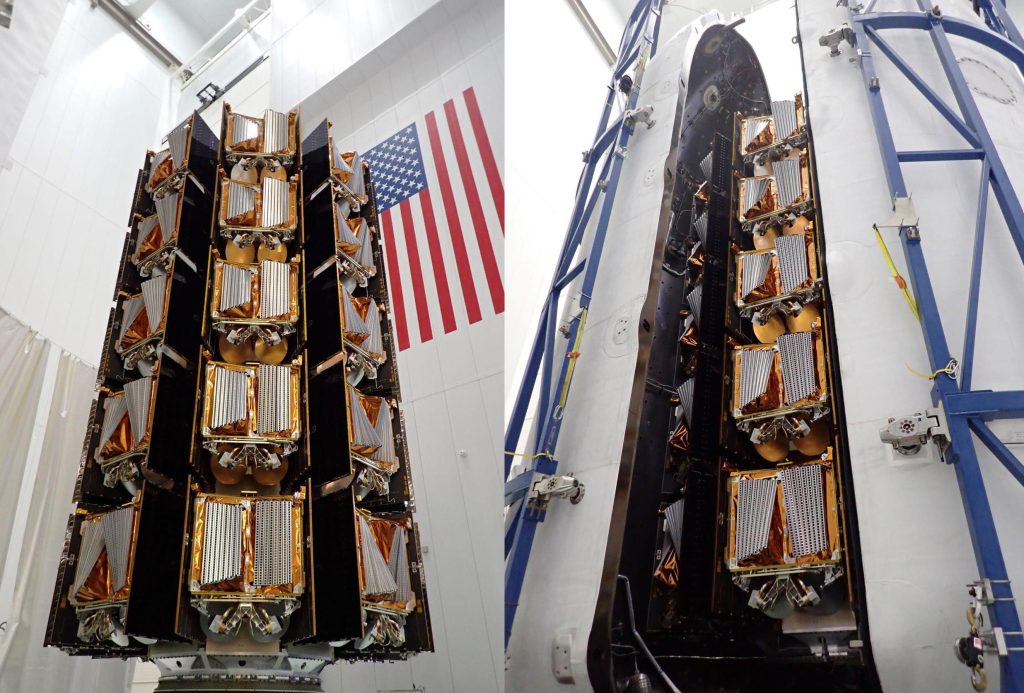

As previously discussed on Teslarati, OneWeb directly competes with SpaceX’s far larger Starlink internet constellation, and refused to engage with the company for launch services – even though Falcon 9 could have likely deployed its satellites more quickly and efficiently – until it was forced to.
“The only reason OneWeb agreed to launch a small subset of its first-generation satellites on SpaceX rockets was a series of egregious actions from Russia that made the pair’s exclusive arrangement too toxic to continue. In June 2015, just 16 months after Russia illegally invaded Ukraine’s Crimea and Donbas regions, OneWeb chose to tie itself at the hip to the unstable aggressor with a firm $1-1.5 billion contract that committed the entirety of its first satellite constellation to 21 Russian Soyuz rockets.
OneWeb nearly escaped consequences from that dubious decision. But in February 2022, Russia doubled down on eight years of small-scale war and Ukrainian occupation with a full-scale, gloves-off invasion with explicit genocidal intent. Europe eventually responded in part with economic sanctions and military supplies that Russia did not appreciate. In response, Russia took a batch of 36 OneWeb satellites hostage, stole the Soyuz rocket OneWeb had already paid for, and killed any possibility of the company completing the six or seven Soyuz launches left under its Arianespace contract. In September 2022, OneWeb announced that it had written off a loss of $229 million as a result of those stolen satellites and rockets.”
Teslarati.com — December 6th, 2022
OneWeb was thus forced to either accept major delays while waiting for European launch options or look elsewhere. OneWeb was able to secure two contracts for India LVM3 rockets, each carrying 36 satellites, but the company chose SpaceX – the only Western launch provider in the world with large amounts of near-term capacity to spare – to launch three batches of 40 satellites.
After its first SpaceX launch, OneWeb should have 500 working satellites in orbit. Another LVM3 launch and two Falcon 9 launches should leave the company with 616 of 648 planned satellites in orbit. It’s unclear how OneWeb intends to launch the 32 remaining satellites.
OneWeb Flight 15 was SpaceX’s 55th successful launch of 2022, leaving the company just five launches away from achieving a 60-launch target set by CEO Elon Musk in March. Following an unintentional 12-day gap between launches caused by several delays, it’s no longer clear if SpaceX can hit that target. SpaceX has never launched later than December 23rd, and it’s extremely unlikely that the company will be able to launch five more times in the next 15 days. Even if it can break through that apparent barrier, it’s also almost impossible to imagine that SpaceX will be able to launch five more times before the end of the year if each mission continues to suffer days or weeks of technical delays.
Originally scheduled to lift off on November 22nd, 29th, 30th, and December 7th, SpaceX’s next mission – carrying a private Japanese Moon lander – is scheduled to launch no earlier than December 11th. After HAKUTO-R, Spaceflight Now reports that SpaceX has another four launches tentatively scheduled this month.
Rewatch SpaceX’s first OneWeb launch here.




News
Tesla FSD fleet is nearing 7 billion total miles, including 2.5 billion city miles
As can be seen on Tesla’s official FSD webpage, vehicles equipped with the system have now navigated over 6.99 billion miles.

Tesla’s Full Self-Driving (Supervised) fleet is closing in on almost 7 billion total miles driven, as per data posted by the company on its official FSD webpage.
These figures hint at the massive scale of data fueling Tesla’s rapid FSD improvements, which have been quite notable as of late.
FSD mileage milestones
As can be seen on Tesla’s official FSD webpage, vehicles equipped with the system have now navigated over 6.99 billion miles. Tesla owner and avid FSD tester Whole Mars Catalog also shared a screenshot indicating that from the nearly 7 billion miles traveled by the FSD fleet, more than 2.5 billion miles were driven inside cities.
City miles are particularly valuable for complex urban scenarios like unprotected turns, pedestrian interactions, and traffic lights. This is also the difference-maker for FSD, as only complex solutions, such as Waymo’s self-driving taxis, operate similarly on inner-city streets. And even then, incidents such as the San Francisco blackouts have proven challenging for sensor-rich vehicles like Waymos.
Tesla’s data edge
Tesla has a number of advantages in the autonomous vehicle sector, one of which is the size of its fleet and the number of vehicles training FSD on real-world roads. Tesla’s nearly 7 billion FSD miles then allow the company to roll out updates that make its vehicles behave like they are being driven by experienced drivers, even if they are operating on their own.
So notable are Tesla’s improvements to FSD that NVIDIA Director of Robotics Jim Fan, after experiencing FSD v14, noted that the system is the first AI that passes what he described as a “Physical Turing Test.”
“Despite knowing exactly how robot learning works, I still find it magical watching the steering wheel turn by itself. First it feels surreal, next it becomes routine. Then, like the smartphone, taking it away actively hurts. This is how humanity gets rewired and glued to god-like technologies,” Fan wrote in a post on X.
News
Tesla starts showing how FSD will change lives in Europe
Local officials tested the system on narrow country roads and were impressed by FSD’s smooth, human-like driving, with some calling the service a game-changer for everyday life in areas that are far from urban centers.

Tesla has launched Europe’s first public shuttle service using Full Self-Driving (Supervised) in the rural Eifelkreis Bitburg-Prüm region of Germany, demonstrating how the technology can restore independence and mobility for people who struggle with limited transport options.
Local officials tested the system on narrow country roads and were impressed by FSD’s smooth, human-like driving, with some calling the service a game-changer for everyday life in areas that are far from urban centers.
Officials see real impact on rural residents
Arzfeld Mayor Johannes Kuhl and District Administrator Andreas Kruppert personally tested the Tesla shuttle service. This allowed them to see just how well FSD navigated winding lanes and rural roads confidently. Kruppert said, “Autonomous driving sounds like science fiction to many, but we simply see here that it works totally well in rural regions too.” Kuhl, for his part, also noted that FSD “feels like a very experienced driver.”
The pilot complements the area’s “Citizen Bus” program, which provides on-demand rides for elderly residents who can no longer drive themselves. Tesla Europe shared a video of a demonstration of the service, highlighting how FSD gives people their freedom back, even in places where public transport is not as prevalent.
What the Ministry for Economic Affairs and Transport says
Rhineland-Palatinate’s Minister Daniela Schmitt supported the project, praising the collaboration that made this “first of its kind in Europe” possible. As per the ministry, the rural rollout for the service shows FSD’s potential beyond major cities, and it delivers tangible benefits like grocery runs, doctor visits, and social connections for isolated residents.
“Reliable and flexible mobility is especially vital in rural areas. With the launch of a shuttle service using self-driving vehicles (FSD supervised) by Tesla in the Eifelkreis Bitburg-Prüm, an innovative pilot project is now getting underway that complements local community bus services. It is the first project of its kind in Europe.
“The result is a real gain for rural mobility: greater accessibility, more flexibility and tangible benefits for everyday life. A strong signal for innovation, cooperation and future-oriented mobility beyond urban centers,” the ministry wrote in a LinkedIn post.
News
Tesla China quietly posts Robotaxi-related job listing
Tesla China is currently seeking a Low Voltage Electrical Engineer to work on circuit board design for the company’s autonomous vehicles.

Tesla has posted a new job listing in Shanghai explicitly tied to its Robotaxi program, fueling speculation that the company is preparing to launch its dedicated autonomous ride-hailing service in China.
As noted in the listing, Tesla China is currently seeking a Low Voltage Electrical Engineer to work on circuit board design for the company’s autonomous vehicles.
Robotaxi-specific role
The listing, which was shared on social media platform X by industry watcher @tslaming, suggested that Tesla China is looking to fill the role urgently. The job listing itself specifically mentions that the person hired for the role will be working on the Low Voltage Hardware team, which would design the circuit boards that would serve as the nervous system of the Robotaxi.
Key tasks for the role, as indicated in the job listing, include collaboration with PCB layout, firmware, mechanical, program management, and validation teams, among other responsibilities. The role is based in Shanghai.
China Robotaxi launch
China represents a massive potential market for robotaxis, with its dense urban centers and supportive policies in select cities. Tesla has limited permission to roll out FSD in the country, though despite this, its vehicles have been hailed as among the best in the market when it comes to autonomous features. So far, at least, it appears that China supports Tesla’s FSD and Robotaxi rollout.
This was hinted at in November, when Tesla brought the Cybercab to the 8th China International Import Expo (CIIE) in Shanghai, marking the first time that the autonomous two-seater was brought to the Asia-Pacific region. The vehicle, despite not having a release date in China, received a significant amount of interest among the event’s attendees.








